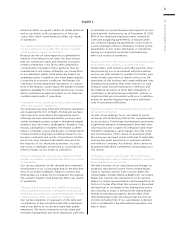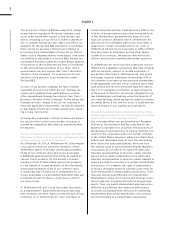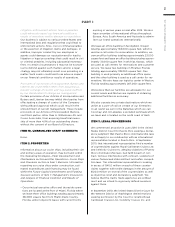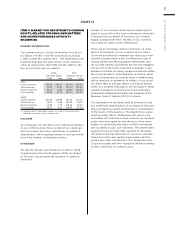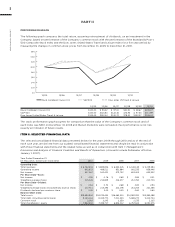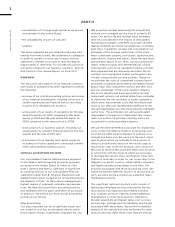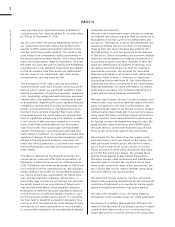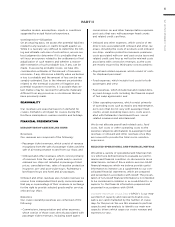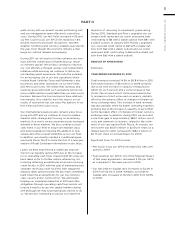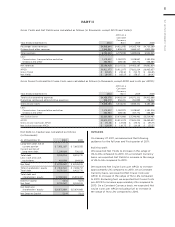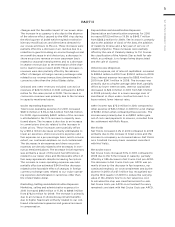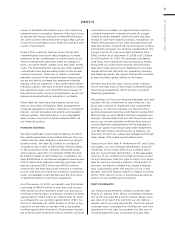Royal Caribbean Cruise Lines 2010 Annual Report Download - page 44
Download and view the complete annual report
Please find page 44 of the 2010 Royal Caribbean Cruise Lines annual report below. You can navigate through the pages in the report by either clicking on the pages listed below, or by using the keyword search tool below to find specific information within the annual report.
PART II
ROYAL CARIBBEAN CRUISES LTD. 41
valuation models, assumptions, inputs or conditions
suggested by actual historical experience.
Contingencies—Litigation
On an ongoing basis, we assess the potential liabilities
related to any lawsuits or claims brought against us.
While it is typically very difficult to determine the tim-
ing and ultimate outcome of such actions, we use our
best judgment to determine if it is probable that we
will incur an expense related to the settlement or final
adjudication of such matters and whether a reason-
able estimation of such probable loss, if any, can be
made. In assessing probable losses, we take into
consideration estimates of the amount of insurance
recoveries, if any. We accrue a liability when we believe
a loss is probable and the amount of loss can be rea-
sonably estimated. Due to the inherent uncertainties
related to the eventual outcome of litigation and
potential insurance recoveries, it is possible that cer-
tain matters may be resolved for amounts materially
different from any provisions or disclosures that we
have previously made.
SEASONALITY
Our revenues are seasonal based on demand for
cruises. Demand is strongest for cruises during the
Northern Hemisphere’s summer months and holidays.
FINANCIAL PRESENTATION
DESCRIPTION OF CERTAIN LINE ITEMS
Revenues
Our revenues are comprised of the following:
• Passenger ticket revenues, which consist of revenue
recognized from the sale of passenger tickets and the
sale of air transportation to and from our ships; and
• Onboard and other revenues, which consist primarily
of revenues from the sale of goods and/or services
onboard our ships not included in passenger ticket
prices, cancellation fees, sales of vacation protection
insurance, pre- and post-cruise tours, Pullmantur’s
land-based tours and hotel and air packages.
Onboard and other revenues also include revenues we
receive from independent third party concessionaires
that pay us a percentage of their revenues in exchange
for the right to provide selected goods and/or services
onboard our ships.
Expenses
Our cruise operating expenses are comprised of the
following:
• Commissions, transportation and other expenses,
which consist of those costs directly associated with
passenger ticket revenues, including travel agent
commissions, air and other transportation expenses,
port costs that vary with passenger head counts
and related credit card fees;
• Onboard and other expenses, which consist of the
direct costs associated with onboard and other rev-
enues, including the costs of products sold onboard
our ships, vacation protection insurance premiums,
costs associated with pre- and post-cruise tours and
related credit card fees as well as the minimal costs
associated with concession revenues, as the costs
are mostly incurred by third-party concessionaires;
• Payroll and related expenses, which consist of costs
for shipboard personnel;
• Food expenses, which include food costs for both
passengers and crew;
• Fuel expenses, which include fuel and related deliv-
ery and storage costs, including the financial impact
of fuel swap agreements; and
• Other operating expenses, which consist primarily
of operating costs such as repairs and maintenance,
port costs that do not vary with passenger head
counts, vessel operating lease costs, costs associ-
ated with Pullmantur’s land-based tours, vessel
related insurance and entertainment.
We do not allocate payroll and related costs, food
costs, fuel costs or other operating costs to the
expense categories attributable to passenger ticket
revenues or onboard and other revenues since they
are incurred to provide the total cruise vacation
experience.
SELECTED OPERATIONAL AND FINANCIAL METRICS
We utilize a variety of operational and financial met-
rics which are defined below to evaluate our perfor-
mance and financial condition. As discussed in more
detail herein, certain of these metrics are non-GAAP
financial measures which we believe provide useful
information to investors as a supplement to our con-
solidated financial statements, which are prepared
and presented in accordance with GAAP. The presen-
tation of non-GAAP financial information is not intended
to be considered in isolation or as a substitute for, or
superior to, the financial information prepared and
presented in accordance with GAAP.
Available Passenger Cruise Days (“APCD”) is our mea-
surement of capacity and represents double occu-
pancy per cabin multiplied by the number of cruise
days for the period. We use this measure to perform
capacity and rate analysis to identify our main non-
capacity drivers which cause our cruise revenue and
expenses to vary.


